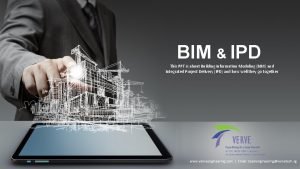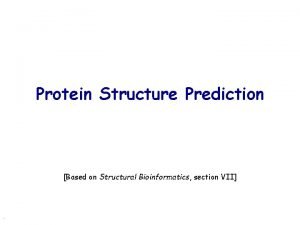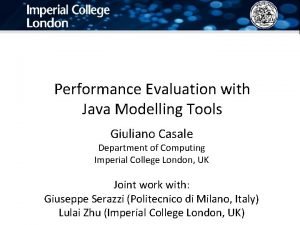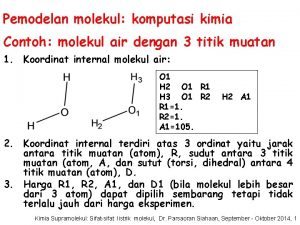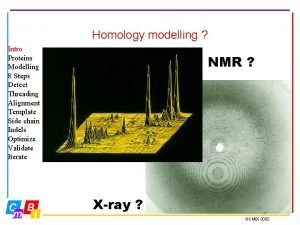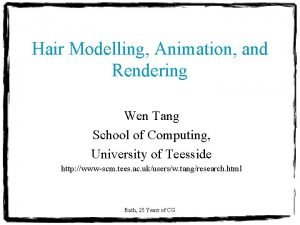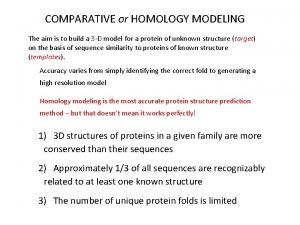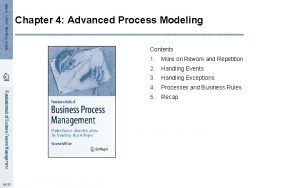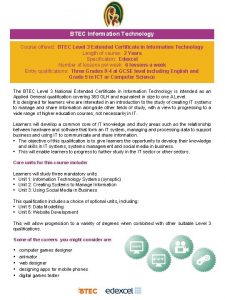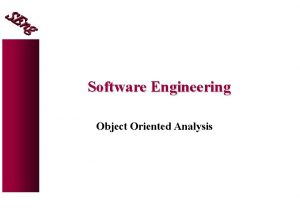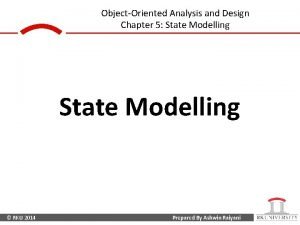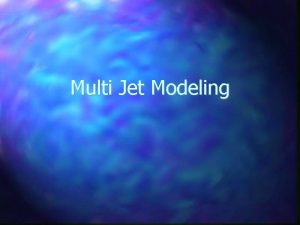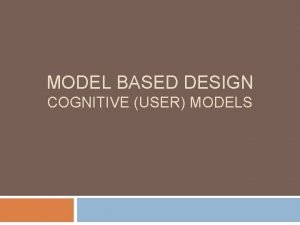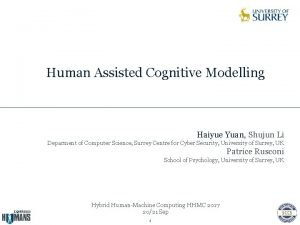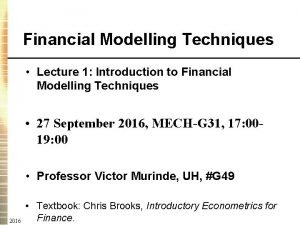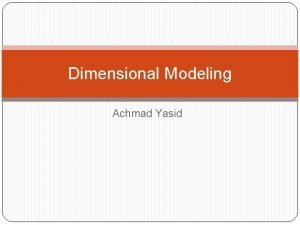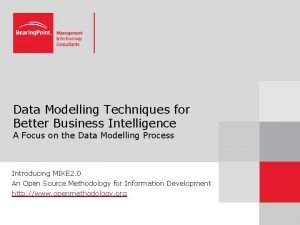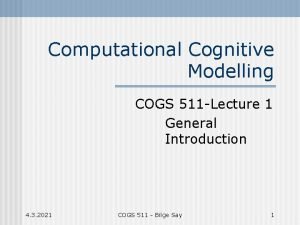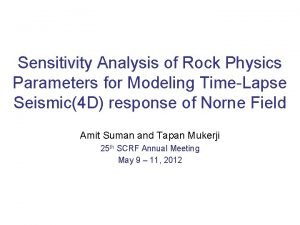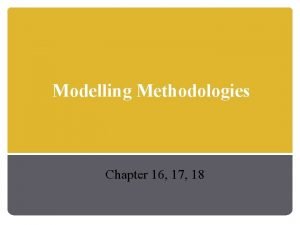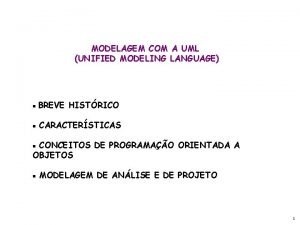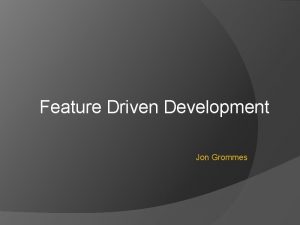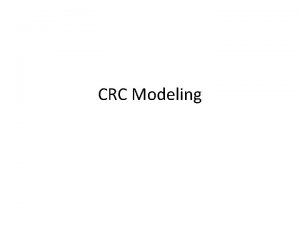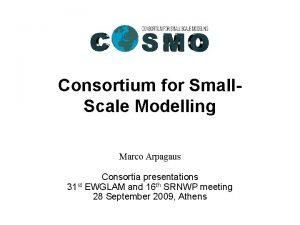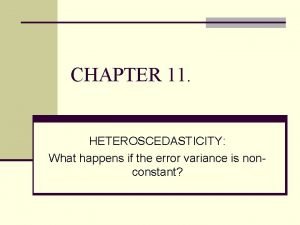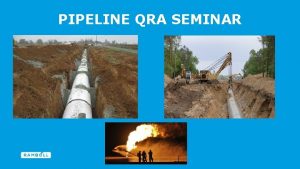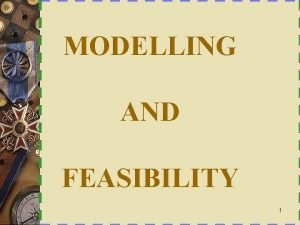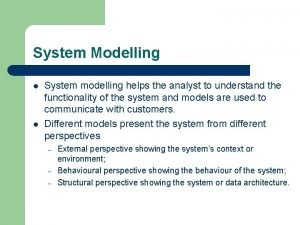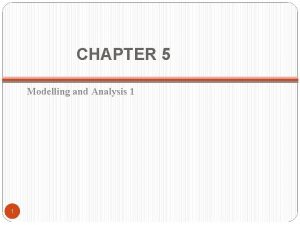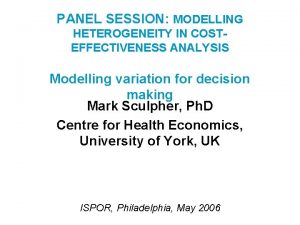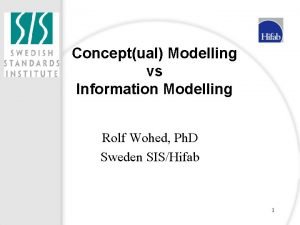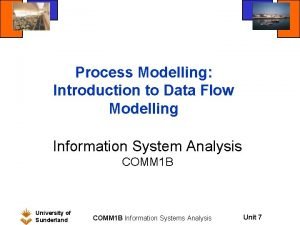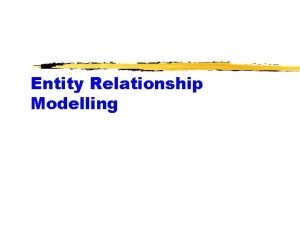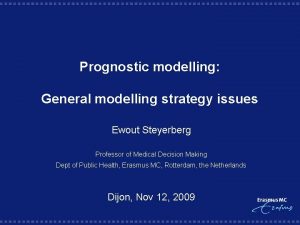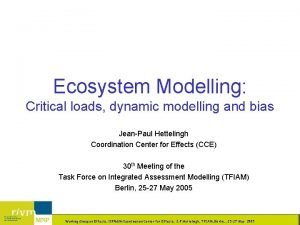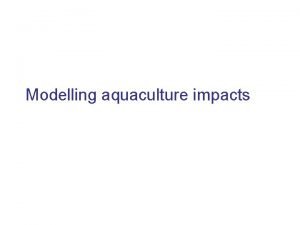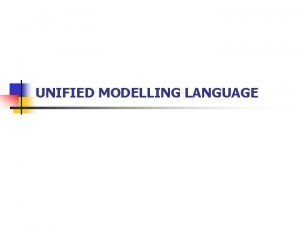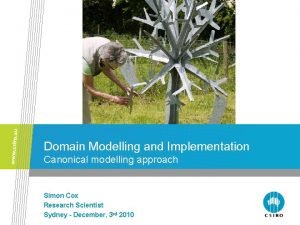Information Modelling What is information system System Analysis










































- Slides: 42

Information Modelling

What is information system? (System Analysis and Design Method, Whitten, Bentley, Dittman, Mc. Grow-Hill, 5 th edition) What is methodology? What is technique? What is tool? framework for comparison of information systems development methodologies Review of the Book Information Systems Development Methodologies, Techniques, and Tools David Avison, Guy Fitzgerald 4 th edition Mc. Grow-Hill 2008

Information Systems & Technology An information system (IS) is an arrangement of people, data, processes, communications, and information technology that interact to support and improve day-to-day operations in a business, as well as support the problem-solving and decision-making needs of management and users. Information technology is a contemporary term that describes the combination of computer technology (hardware and software) with telecommunications technology (data, image, and voice networks). 3

Information Systems Architecture Information systems architecture provides a unifying framework into which various people with different perspectives can organize and view the fundamental building blocks of information systems. 4

Information System Building Blocks 5

Perspectives or Stakeholders System owners pay for the system to be built and maintained. System users use the system to perform or support the work to be completed. System designers design the system to meet the users’ requirements. System builders construct, test, and deliver the system into operation. Systems analysts facilitate the development of information systems and computer applications by bridging the communications gap that exists between nontechnical system owners and users and technical system designers and builders. IT vendors and consultants sell hardware, software, and services to businesses for incorporation into their information systems. 6

Focuses for Information Systems Data—the raw material used to create useful information. Processes—the activities (including management) that carry out the mission of the business. Interfaces—how the system interfaces with its users and other information systems. 7

Front- and Back-Office Information Systems Front-office information systems support business functions that reach out to customers (or constituents). Marketing Sales Customer management Back-office information systems support internal business operations and interact with suppliers (of materials, equipment, supplies, and services). Human resources Financial management Manufacturing Inventory control 8

A Federation of Information Systems 9

Classes of Information Systems Transaction processing systems Management information systems Decision support systems Expert systems Office automation systems 10

Transaction Processing Transaction processing systems are information system applications that capture and process data about business transactions. Includes data maintenance, which provides for custodial updates to stored data. Business process redesign (BPR) is the study, analysis, and redesign of fundamental business (transaction) processes to reduce costs and/or improve value added to the business. 11

Management Information Systems A management information system (MIS) is an information system application that provides for management-oriented reporting. These reports are usually generated on a predetermined schedule and appear in a prearranged format. 12

Decision Support Systems A decision support system (DSS) is an information system application that provides its users with decisionoriented information whenever a decision-making situation arises. When applied to executive managers, these systems are sometimes called executive information systems (EIS). A data warehouse is a read-only, informational database that is populated with detailed, summary, and exception data and information generated by other transaction and management information systems. The data warehouse can then be accessed by end-users and managers with DSS tools that generate a virtually limitless variety of information in support of unstructured decisions. 13

Expert Systems An expert system is a programmed decision-making information system that captures and reproduces the knowledge and expertise of an expert problem solver or decision maker and then simulates the “thinking” or “actions” of that expert. Expert systems are implemented with artificial intelligence technology that captures, stores, and provides access to the reasoning of the experts. 14

Office Automation Systems Office automation (OA) systems support the wide range of business office activities that provide for improved work flow and communications between workers, regardless of whether or not those workers are located in the same office. Personal information systems are those designed to meet the needs of a single user. They are designed to boost an individual’s productivity. Work group information systems are those designed to meet the needs of a work group. They are designed to boost the group’s productivity. 15

Information Systems Applications 16

Methodologies A collection of procedures, techniques, tools, and documentation aids which will help the system developers in their efforts to implement a new information system. A methodology will consists of phases, themselves consisting of sub phases, which will guide the systems developers in their choice of the techniques that might be appropriate at each stage of the project and also help them plan, manage, control, and evaluate information systems projects. (25 different metthodologies) 17

Avison & Taylor identified 5 classes of situation and appropriate approaches: Class 1: well-structured, defined problems, clear requirements traditional methodology (SSADM) Class 2: as above but unclear requirements data or process model (JSD or STRADIS) Class 3: unstructured, unclear objectives soft systems approach (SSM) Class 4: high user-interaction systems a people-focussed, like ETHICS Class 5: very unclear situations a contingency approach (Multiview) However: methodologies are NOT stable there a variety of versions out there and practice is often different to that prescribed 18

1. Philosophy • Paradigm • Objectives • Domain • Target Avison & Fitzgerald’s framework for comparison of information systems development methodologies: 2. Model 3. Techniques and tools 4. Scope 5. Outputs 6. Practice • Background • User base • Players 7. Product not addressed SPEED? QUANTITY? USER MODIFICATION? 19

Philosophy: distinguishes a “method” from a “methodology” may be explicit but in most methodologies is implicit a set of principles that underlie the methodology NOT just wishing to improve the world of information systems development this is perhaps the most important aspect when comparing methodologies - nearly ALL the features are highly dependent upon the philosophy and without this understanding, the methodology is difficult to explain 20

Philosophy: • paradigm a specific way of thinking about problems science “reduce the complexity of the variety of the real world in experiments whose results are validated by their repeatability, and thereby build knowledge by the refutation of hypotheses” systems “Checkland argues that human activity systems … do not display such characteristics, they have emergent properties (that is the whole is greater than the sum of the parts)” implies that breaking things down into smaller parts does not disrupt the system HARD THINKING systems paradigm concern is with the whole picture, the emergent properties and inter-relationships SOFT 21

Philosophy: • paradigm the study of the nature and essence of things theory of knowledge ONTOLOGY EPISTEMOLOGY Realism Positivism Nominalism Positivism Interpretivism Objectivist Approaches EPISTEMOLOGY Subjectivist Approaches Interpretivism Realism Nominalism ONTOLOGY 22

Realism “postulates that the universe comprises objectively given, immutable objects and structures. These exist as empirical entities, on their own, independent of the observer’s appreciation of them” Nominalism “reality is not a given immutable ‘out there’, but is socially constructed. It is the product of the human mind. Social relativism is the paradigm adopted for understanding social phenomena and is primarily involved in explaining. . . the social process of reality construction” Positivism implies the existence of causal relationships which can be investigated using scientific method Interpretivism implies there is no single truth that can be “proven” by such investigation. Different views and interpretations are potentially legitimate and the way to progress is not to try and discover the one “correct” view but to accept the differences and seek to gain insight by a deep understanding of such complexity. 23

Objectivist: largely embodied in techniques such as entity relationship modelling or data flow diagrams Objectivist Approaches Subjectist: most areas involving people’s lives; may include “facts”, like sales targets which are negotiated Subjectivist Approaches it is clear SSM adopts the systems paradigm the subjectivist approach. The participative approach of ETHICS analyses the work system without decomposition. STRADIS, YSM, IE, SSADM, Merise, JSD, OOA are all reductionist, accept the ontological position of realism and so firmly belong in the science paradigm “the only way to solve complex problems is to divide them into sub-problems until they become manageable. A requirement for this to work is that the solution to the sub-problems gives the solution for the problem as a whole, that is, that the division in sub-problems is coherent. ” 24

Philosophy: • objectives • domain • target automation the organisation Is it aimed at particular types of application, types of problem, size of system or environment? determines the boundaries of the area of concern “the problem with concentrating only on aspects to be computerised is that this is an artificial boundary in terms of the logic of the business. There is no reason why the solution to a particular problem should reside only in the area that can be automated. ” what is the reality of the methodology being “general purpose”? in choosing and understanding a methodology, it might be a good idea to ask the question: “could the use of this methodology lead to the implementation of a purely organisational or manual solution? ” It is interesting to note that most of the widely-used commercial methodologies would give “No”, whereas most academic methodologies would probably give “Yes”, excepting BPR. 25

Different assumptions A system that: Makes most ust of computers is a good solution. Produces the most appropriate documentation is a good solution. Is the cheapest to run is a good solution. Is implemented earliest is a good solution Is the most adaptable is a good solution. That makes the best use of the techniques and tools available is a good solution. That is liked by the stakeholders is a good solution. 26

Types of Methodologies 1 - Process Oriented: Structured analysis, design and implementation of information systems (STRADIS) Yourdon Systems Method (YSM) Jackson Systems Development (JSD) 2 - Blended: Structured Systems Analysis and Design Method (SSADM) Merise Information Engineering Welti ERP Development 27

Types of Methodologies 3 - Object – Oriented: • Object-oriented analysis (OOA) • Rational Unified Process (RUP) 4 - Rapid Development: • James Martin’s RAD • Dynamic Systems Development Method (DSDM) • Extreme Programming (XP) • Web Information Systems Development Methodology (WISDM) 28

Types of Methodologies 5 - People – Oriented: • Effective Technical and Human Implementation of Computer-based Systems (ETHICS) • KADS • Common. KADS 6 - Organizational oriented: • Soft Systems Methodology (SSM) • Information Systems Work and Analysis of Change (ISAC) • Process Innovation (PI) • Projects in Controlled Environments (PRINCE) • Renaissance 7 - Frameworks • Multiview • Strategic Options Development and Analysis (SODA) • Capability Maturity Model (CMM) • Euromethod 29

Technique Is a way of doing a particular activity in the information systems development process, and any particular methodology may recommend techniques to carry out many of these activities. (29 different techniques) 30

Types of Techniques 1 - Holistic: Rich pictures Root definitions Conceptual Models Cognitive Mapping 2 -Data: Entity Modelling Normalization 3 -Process: Data Flow Diagramming Decision Tree Decision Tables Structured English Structure Diagrams Structured Walkthroughs Matrices Action Diagram Entity Life Cycle 31

Types of Techniques 4 - Object Oriented: Object Orientation Unified Modeling Language (UML) 5 -Project Management Estimation Techniques PERT Charts Gantt Charts 6 -Process: Lateral Thinking Critical Success Factors (CSFs) Scenario Planning Future Analysis Strengths, Weaknesses, Opportunities, and Threats Analysis (SWOT) Case – based Reasoning Risk Analysis 7 - People: Stakeholder Analysis Joint Application Development 32

basis of the methodology’s view of the world an abstraction Model: 4 categories of models: • Verbal • Analytic • Iconic • Simulation IS methodology models of this type this dominance is because of the perceived importance of communication between users and analysts the “essence” without compromise abstraction: stripping an idea or a system of its concrete or physical features - provides a way of viewing important aspects of the system at various levels the detail “the process of abstraction loses information and so a model should only lose that information which is not part of the “essence” of the system. ” Abstraction is closely related to hierarchical decomposition. “Natural” levels of decomposition, are • conceptual • logical • physical 33

a description of the universe of discourse “Natural” levels of decomposition: • conceptual • logical • physical Concept: “…the definition of the problem structure of an IS, like a map defines the problem structure of a transport system. ” Logical level: a description of the IS without any reference to the technology that could be used to implement it - its scope is the IS itself not the Uo. D mainly to provide requirements specification of the IS Physical level: a description of the IS including the technology of the particular implementation 34

Tools: Project management tools: Microsoft Project Database management systems: ACCESS Drawing tools: Microsoft Visio CASE tools: Power Designer, Rational Rose Website Development: Dreamweaver Groupware: Group. Systems 35

Techniques & Tools: many methodologies include techniques as part of them- STRADIS, YSM, SSADM and JSD some, like ISAC, do not rely on particular techniques some, like IE, explicitly suggest that techniques are not a fundamental part of the methodology and that recommended techniques can be replaced as better ones come along SSADM, Merise and IE stress a separation between data and processes so these methodologies would not fit well with an object-oriented modelling technique which integrates the two 36

Techniques & Tools: SSM does not even MENTION tools, let alone recommend the use of particular ones. However, many methodologies do - YSM, IE, SSADM, Merise, JSD, OOA and Process Innovation they range from simple drawing tools to those which support the whole development process, including prototyping, project management and code generation IE, like RAD, suggest developments shouldn’t proceed with the use of tools SSADM and OOA suggest tools are helpful but not essential 37

PI SSM ETHICS ISAC OOA JSD Merise SSADM IE YSM STRADIS Scope: Strategy Feasibility Analysis Logical design Physical design Programming Testing Implementation Evaluation Maintenance SCOPE OF METHODOLOGIES Strategy is used to indicate any aspects which relate to organisationwide context and deals with overall IS strategy, purpose and planning Comparisons do not include Multiview (a combinational methodology), RAD (similar to IE), KADS (applied to expert systems only) or Euromethod (simply a framework) 38

Outputs: Can vary from being an analysis specification to a working implementation of the system Can be considerable variation not only in terms of what should be produced but also in the level of detail that the methodology specifies Related to whether the methodology is a: “blueprint” for action “framework” within which analyst has much discretion outputs also help “direct” the analyst - let them know that they are proceeding correctly some outputs may be described in great details but not how to generate them viz. ISAC’s analysis of change using A-graphs 39

Practice: • background • user base • players Wasserman et al (1983). Characteristics of software development methodologies. In: Olle et al. (1983). Information systems design methodologies: A feature analysis. Pub. North Holland, Amsterdam. the use of the methodology commercial Origins? academic Vendors would have you believe anyone who enquired about the methodology was actively using it! Of 24 methodologies investigated nearly half had been used in 10 or fewer projects Informatics survey of ~60 users in 1990: 19 SSADM 12 JSD 9 IE 8 YSM 11 in-house In France Merise is used in between 2061% of cases 40

Practice: • background • user base • players Who is supposedly involved with the use of the methodology? What roles do they perform? traditional view is that of a specialist team of professional systems analysts and designers + professional programmers - STRADIS, YSM, IE, SSADM, Merise, JSD and OOA in ETHICS the users themselves perform the analysis and design and consultants are used when required and a facilitators are central to the methodology SSM, ISAC, PI and ETHICS have a different view: users have a more proactive role some level of skill is always Some methodologies also require considerable required user skills but training may not be explicitly included for users ETHICS does so 41

Product: What is supplied when purchasing a methodology? likely to be a “minimum set” with extras: add-ins • Software • development support tools • written documentation • agreed number of training hours • telephone help service • consultancy maybe a large set of manuals, the recipes, like SSADM or a set of academic articles, like SSM some come with certificated training courses, consultants and facilitators 42
 Ipd ppt
Ipd ppt Graphical modelling tool for structured analysis
Graphical modelling tool for structured analysis Edlc full form in embedded system
Edlc full form in embedded system What is technological modelling
What is technological modelling Homology modelling steps
Homology modelling steps Giuliano casale
Giuliano casale Molecular modelling laboratory
Molecular modelling laboratory Modelling madness
Modelling madness Modelling rich interaction
Modelling rich interaction Lbo case study practice
Lbo case study practice Geometric modeling in cad
Geometric modeling in cad Homology modelling steps
Homology modelling steps Hair modelling
Hair modelling Homology modelling steps
Homology modelling steps Advanced process modelling
Advanced process modelling Mathematical modelling of electrical systems
Mathematical modelling of electrical systems Modelling rich interaction
Modelling rich interaction Unit 5 data modelling assignment 2
Unit 5 data modelling assignment 2 Algorithmic cost modelling
Algorithmic cost modelling Class responsibility collaborator modelling
Class responsibility collaborator modelling State modelling
State modelling Sequence diagram penarikan uang di atm
Sequence diagram penarikan uang di atm Multi-jet modeling
Multi-jet modeling An introduction to model-based cognitive neuroscience
An introduction to model-based cognitive neuroscience Cognitive modelling
Cognitive modelling Financial modelling techniques
Financial modelling techniques Menurut anda apa tujuan dari dimensional modelling....?
Menurut anda apa tujuan dari dimensional modelling....? Data modelling techniques in business intelligence
Data modelling techniques in business intelligence Malatesta's modelling e.g. by mother
Malatesta's modelling e.g. by mother Cognitive modelling
Cognitive modelling Modelling relationships and trends in data
Modelling relationships and trends in data Threat modelling web application
Threat modelling web application 150000/175
150000/175 Modelling
Modelling Data modelling methodologies
Data modelling methodologies Language
Language Disease modelling
Disease modelling Modelling software
Modelling software Crc modeling
Crc modeling Modelling
Modelling Consequences of heteroscedasticity
Consequences of heteroscedasticity Solid
Solid Qra software
Qra software
